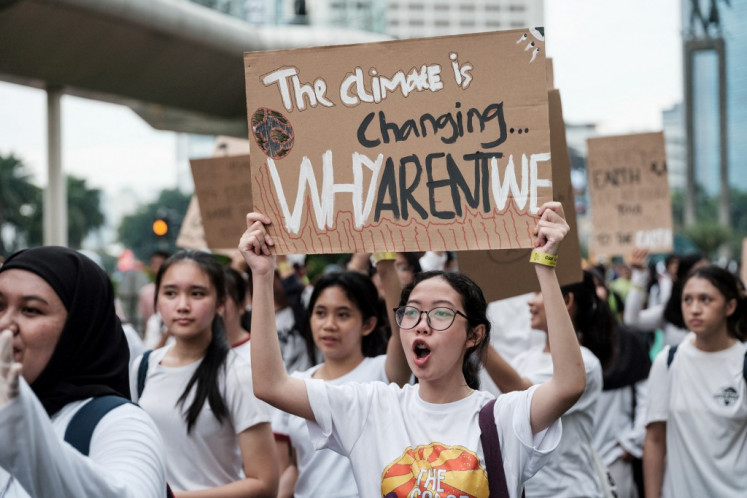Good Living: PROTECTING FORESTS
SCIENTIFIC INNOVATIONS TO MITIGATE CLIMATE CHANGE IN INDONESIAWords Sebastian PartogiClimate change and environmental destruction are the globeâs greatest problems and the international environmental NGO The Nature Conservancy (TNC) wants to do something about it
Change Size

SCIENTIFIC INNOVATIONS TO MITIGATE CLIMATE CHANGE IN INDONESIA
Words Sebastian Partogi
Climate change and environmental destruction are the globe's greatest problems and the international environmental NGO The Nature Conservancy (TNC) wants to do something about it.
TNC recently convened in Jakarta a discussion titled 'Applying Smart Development Approaches to Address Environmental and Social Issues in Key Industry Sectors', which explored how environmental protection programs have been implemented in Indonesia since 1991.
On the global level, according to the TNC, 20 percent of the world's remaining natural lands are at risk of being converted for development, including energy, mining, agriculture and urban expansion. Only five percent of these lands have some level of protection.
Indonesia has one of the fastest rates of deforestation, ranking fifth globally, behind Russia, Brazil, the US and Canada.
Furthermore, the TNC stated that Indonesia loses over one million hectares of forests annually due to conversions to oil palm and timber plantations, illegal logging as well as due to unsustainable and destructive forest harvesting.
Despite these problems, the Indonesian Geospatial Agency's (BIG) deputy for thematic geospatial information, Nurwadjedi, said that efforts to mitigate climate change in Indonesia have not been science-based, leading to a lack of holistic policies that could be implemented via accurate and effective intervention programs.
As example, he cited the Spatial Planning Law, which stipulates that at least 30 percent of river basin areas (DAS) be allocated for forests and at least 30 percent of urban areas allocated for green open spaces.

Bogor Agriculture Institute (IPB) regional study and planning head Ernan Rustiadi echoed Nurwadjedi. 'Different river basin areas and urban landscapes have different thresholds for forest or open green spaces. Therefore, we can't mitigate the carbon emission problem adequately if we keep the number fixed at 30 percent.'
He added that the National Long-Term Development Plan (RPJP) also failed to include detailed green area protection plans, as the document is only 100 pages and offers only broad guidelines.
To address Indonesia's problems scientifically, the TNC is offering the country one of its climate change mitigation initiatives, called Development by Design (DnD).
According to TNC DnD director and lead scientist Joseph Kiesecker, the initiative offers governments and companies scientific and data-based sustainable development programs.
Scientific, in this case, means measurable, well-designed and adhering to a rigorous methodology.
The initiative comprises four steps'avoidance, minimization, restoration and offset'and was developed based on field data obtained from site-based and landscape-scale maps, the integration of environmental impact assessments into landscape plans and advanced mitigation planning to understand the characteristics of different landscapes.
'This approach coordinates all relevant stakeholders for environmental sustainability, namely the government, companies and local residents, and helps them take a broader perspective on climate change,' he said.
The NGO has tried the approach in Brazil, a country with tropical climate like Indonesia, resulting in at least 94 percent of species conserved, among several environmental sustainability targets.
TNC director Rizal Algamar said that through the DnD approach, the organization helped companies, local governments and local residents to assess, plan, execute and evaluate sustainable development programs over five to 10 years.
'After the assessment program is finished, we conduct an outreach program based on our field findings to take part in a two-way education program involving all relevant stakeholders, especially local residents, on the contribution of biodiversity to their economic welfare so that they could take part in protecting their environment with the help of satellites and a land patrolling system,' Kiesecker.
According to Kiesecker, local residents typically understand the importance of land protection. However, convincing governments and companies that sustainability is good for long-term investment is a bigger challenge.
'We usually convince companies and governments to adopt a sustainable approach by reminding them of the fact that land utilization for mining and palm oil plantation typically spans more than 25 years, he says. 'Keeping this in mind, five to 10 years of sound planning could result in high return of investment in terms of renewed natural resources.'

According to Kiesecker, one factor that has made companies reluctant to adopt sustainable development is a lack of competent human resources.
'Human resources from multinational companies have relatively more awareness of environmental issues than their local counterparts, because they adopt policies from their principals, who have been operating much longer than the local ones. This is why, one of our biggest challenges right now is to boost the awareness of local companies.'









